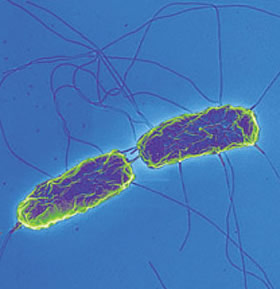Salmonella enterica serovar Typhi: Difference between revisions
| Line 44: | Line 44: | ||
===Virulence Factors=== | ===Virulence Factors=== | ||
Most of the bacterium's virulence arises from <i>Salmonella</i> pathogenicity islands, also known as SPI. These islands encode for the majority of effector molecules associated with pathogen virulence. For example after entering a host cell, <i>Salmonella. typhi</i> will secrete effector proteins including SIPA and SptP. These proteins will alter the actin cytoskeleton of the host cell, which is responsible for cell migration.<br> | |||
This intracellular bacterium also expresses Vi antigen on it's surface. The antigen resides within a polysaccharide capsule which is essential for increased virulence and severity of symptoms. It is believed that this capsule also prevents lipopolysaccharide recognition by pattern recognition receptors in order to prevent immune response, however further research is required. Secretion of the protein invasin will allow non-phagocytic cells to ingest the bacterium in order to allow intracellular access leading to the inhibition of oxidative leukocytes, and rendering the innate immune response ineffective. Other possible factors include ion transporters, fimbrae, and flagella required for attachment and colonization. [[#References|[7]]] | |||
<br> | <br> | ||
Revision as of 21:53, 16 July 2014


Etiology/Bacteriology
Taxonomy
| Domain = Bacteria | Phylum = Proteobacteria | Class = Gammaproteobacteria | Order = Enterobacteriales | Family = Enterobacteriaceae | Genus = Salmonella | species = S. enterica
Description
Salmonella enterica is a gram-negative facultative anaerobe with the ability of motility. This bacterium also lacks the ability to ferment lactose. Typhoid fever is caused by the specific serotype Salmonella tyhphi. [3]
Pathogenesis
Transmission
Fecal-oral transmission via contaminated water, vegetables, eggs, meat, poor hygiene Humans serve as only viable reservoir to Salmonella typhi. This bacterium resides primarily in the blood stream and intestinal tract. [4] To gain access to the host, this bacterium first adheres to the mucosal lining and invades epithelial cells. Next, this pathogen encounters dendritic cells in the innate immune system and begins to compromise enterocytes, macrophages in the submucosa. The bacterium enters Peyer’s patches and messenterial lymph nodes in the reticulo-endothelial system and blood stream. Secondary infection occurs in the bone marrow, liver, spleen, and gall bladder. Severe symptoms associated with this infection include necrosis of Peyer’s patches along with peritonis, sepsis, toxic encephalopathy with myocarditis leading to haemodynamic shock. [5]
Infectious dose, incubation, and colonization
ID50: 10^3-10^6 bacilli [6]
Incubation period: 7-14 days
To colonize, S. typhi adheres to the mucosal lining of the small intestine and penetrates the epithelial cells. The bacterium spreads to the peripheral lymphoid organs during secondary infection. The gallbladder serves as the primary reservoir of chronic infection. The formation of biofilms in the gut and on gallstones is a critical factor in the carriage and shedding of S. typhi. [5]
Epidemiology
This disease is a major factor in countries that lack access to purified water; for example India, South America, Southeast Asia, and Africa, placing children at especially high risk that play in sewage water on the streets. 80% of cases come from Bangladesh, India, China, Indonesia, Nepal, Laos, Vietnam, or Pakistan. [6] There are more than twenty-seven million cases annually, and two-hundred seventeen thousand deaths world-wide each year. [5]
Virulence Factors
Most of the bacterium's virulence arises from Salmonella pathogenicity islands, also known as SPI. These islands encode for the majority of effector molecules associated with pathogen virulence. For example after entering a host cell, Salmonella. typhi will secrete effector proteins including SIPA and SptP. These proteins will alter the actin cytoskeleton of the host cell, which is responsible for cell migration.
This intracellular bacterium also expresses Vi antigen on it's surface. The antigen resides within a polysaccharide capsule which is essential for increased virulence and severity of symptoms. It is believed that this capsule also prevents lipopolysaccharide recognition by pattern recognition receptors in order to prevent immune response, however further research is required. Secretion of the protein invasin will allow non-phagocytic cells to ingest the bacterium in order to allow intracellular access leading to the inhibition of oxidative leukocytes, and rendering the innate immune response ineffective. Other possible factors include ion transporters, fimbrae, and flagella required for attachment and colonization. [7]
Clinical Features
Symptoms include a sustained fever of 103-104° F, weakness, abdominal pain, appetite loss, rose-colored spots, self-limiting diarrhea, weight loss, delirium, and malaise. In severe cases this disease can cause intestinal perforation and peritonitis, toxic encephalopathy associated with myocarditis and hemodynamic shock that can lead to death within one month of infection. [8]
Diagnosis
Stool cultures are used to diagnose the disease, but frequently must be suplemented with blood cultures to reach a confident diagnosis due to the sensitivity of the stool cultures in the early and late stages of illness. The blood cultures from the infected host can be tested on MacConkey agar and EMB agar. [7] [9]
Treatment
Antibiotic therapy, specifically ciprofloxacin and ampicillin, are the only effective treatment. For pregnant women ceftriaxone is used. Recently, antibiotic resistance by this bacterium is increasing and developing into a more serious issue concerning the effectiveness and use of antibiotics. To stimulate recovery, fluids and a healthy diet can be administered in addition to antibiotics. [9]
Prevention
To avoid infection, hygiene such as clean hands and treated water is encouraged. Boiling water and correct procedure when handling raw fruits and vegetables decrease the risk of infection. [10] In association, two vaccines are available: inactivated typhoid vaccine administered via injection and live typhoid vaccine administered orally. [4]
References
1 University of Oklahoma Faculty and Staff.
2 Kenyan Waterborne Disease Center
3 "Salmonella Typhi" Salmonella Typhi.
4 "Typhoid Fever" Center for Disease Control and Prevention.
5 de Jong, H.K., Parry, C.M., van der Pol, T. "Host-Pathogen Interaction in Invasive Salmonellosis" PLOS Pathogens.
6 Brusch, J.L. "Typhoid Fever" Medscape.
7 Pollack, D.V. "Salmonella enterica Typhi" University of Connecticut.
8 "Diseases and Conditions: Typhoid Fever" Mayo Clinic.
9 Balentine, J.R. "Typhoid Fever" Medicine Net.
10 "Typhoid Fever" Medline Plus.
